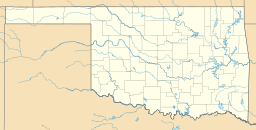Lone Chimney Lake facts for kids
Quick facts for kids Lone Chimney Lake |
|
|---|---|
| Lower Black Bear Creek Watershed Dam 19M | |
| Location | Pawnee County, Oklahoma (extends into Payne County, Oklahoma) |
| Coordinates | 36°14′27″N 96°50′10″W / 36.24083°N 96.83611°W |
| Primary inflows | Camp Creek |
| Primary outflows | Camp Creek |
| Basin countries | United States |
| Built | 1980 |
| Surface area | 550 acres (220 ha) |
| Water volume | 5,722 acre⋅ft (7.058 hm3) |
| Shore length1 | 17 mi (27 km) |
| Surface elevation | 939 ft (286 m) |
| 1 Shore length is not a well-defined measure. | |
Lone Chimney Lake is a lake located in Pawnee County, Oklahoma. It is found just east of Glencoe. Part of the lake also reaches into southern Payne County, Oklahoma.
This lake was built in 1980. Several groups worked together to create it. These included the Tri-County Development Authority, the Pawnee County Conservancy District, and the Black Bear Conservancy District. They also got help from the Oklahoma Conservation Commission and the USDA Natural Resources Conservation Service.
Contents
Why Lone Chimney Lake Was Built
The main reason Lone Chimney Lake was created was to help control floods. It was part of a bigger plan for the Lower Black Bear Creek Watershed. This plan included 19 dams designed to stop flooding.
Before these dams were built, the area had many floods. Between 1935 and 1954, there were 7 major floods and 73 smaller ones. The dams were built to prevent such damage.
Water for Local Towns
As the lake was being planned, its purpose was changed slightly. It was decided that the lake would also store water for towns to use. This added 4,212 acre-feet (5,195,000 m3) of water storage.
Lone Chimney Lake became the main water source for several small communities. These include Glencoe, Morrison, Yale, Blackburn, Skeede, Maramec, and Terlton, Oklahoma. It also provides extra water for larger towns like Cleveland and Pawnee, Oklahoma.
Lake Size and Features
The surface of Lone Chimney Lake covers about 550 acres (2,200,000 m2). Its shoreline stretches for about 17 miles (27 km).
The Oklahoma Water Resources Board has slightly different numbers. They say the shoreline is 18 miles (29 km) long. The normal water surface area is 518 acres (2,100,000 m2). The lake can hold about 5,722 acre-feet (7,058,000 m3) of water. Its normal height above sea level is 939 feet (286 m).
Dealing with Dry Spells
Lone Chimney Lake has faced challenges due to long periods of dry weather. These dry spells have affected the lake for almost ten years.
Drought Problems in 2006
In 2006, the lake almost ran out of water for towns. People were using a lot of water, and the lake level dropped. The pipe that takes water out of the lake was above the water. A special floating pipe had to be installed. This cost about $19,000, but it allowed the lake to keep supplying water.
Water Shortages and Solutions
In December 2011, the lake again had very low water levels. Towns had to start limiting how much water people could use.
In June 2012, the City of Stillwater agreed to help. They decided to sell Lone Chimney Water Association up to 2,000,000 US gallons (7,600 m3) of treated water each month for 30 years. This was a big help during the drought.
By 2012, the drought had made it hard to supply water to about 16,000 customers. The lake level had dropped 11 feet (3.4 m) below normal. One water intake pipe was completely out of the water. Another was partly out. By January 2014, news reports said the lake was only a few weeks away from running dry.
Recovery and Future Plans
Record rainfall in May and June 2015 greatly improved the lake's water level. The water rose from 14 feet (4.3 m) below normal to only 6 feet (1.8 m) below normal.
However, the water still needs to rise more for boat ramps to be used again. Fishing piers are still far above the water. The land around them has grown over with bushes that need to be cleared.
The Lone Chimney water treatment plant closed several years ago. It has not been reopened. This plant used a chloramine treatment process. The water from Stillwater uses a different process called chlorination. The water board needs to decide if they will change their old plant to match Stillwater's process or treat Stillwater's water differently.


